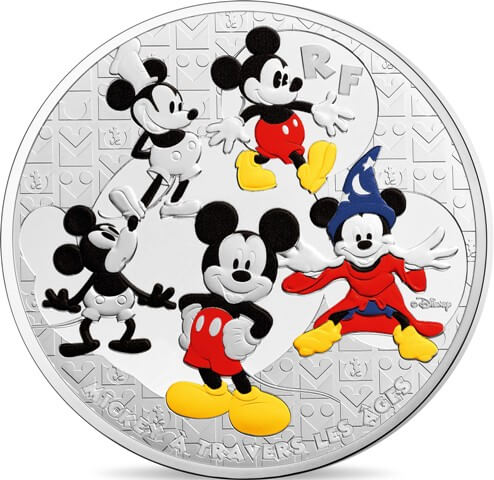From Being Considered ‘Trash’ to Representing National Values – How Comics Came to be Featured on Coins.
So, how do we decide what motifs to feature on coins? Well, coin motifs usually depict figures or events that impact us as a society or a nation. They refer to themes that we identify with and that are generally highly regarded. Of course, what we consider to be ‘coin worthy’ changes over time. In this article, we’ll be discussing how comic book and cartoon characters came to be featured on coins – and how they gradually became established coin motifs.
It’s a very long story, that much is clear. Comics first gained real popularity in the USA. But after the end of the Second World War, comic book characters such as Mickey Mouse and Superman, which are still famous to this day, took the whole world by storm – not least because American soldiers often took comics with them.
Absolute Trash!
In Europe especially, comics were initially considered a ‘trashy’, lowbrow form of literature. Children took to the new format quickly, while their parents often remained sceptical. Children should be reading proper books, thank you very much, books that actually teach you something! Instead of just staring at these silly little pictures! They’ll rot your brain! I’m sure many of our readers will remember their own parents saying things like this to them when they were children, to dissuade them from reading comics like Mickey Mouse, Spiderman or Asterix.

Where comic-lovers can buy rare items, show off their home-made costumes and meet actors and fellow fans: ‘Comic Cons’ have become globally established conventions for fans of comics and other pop culture phenomenons. Image: tunechick83 on Pixabay.
Where Dreams Come True
Of course, a lot has changed since then. Nowadays, comics books and their main characters represent an essential facet of popular culture. The superheroes created by Marvel and DC have conquered the big screen; Disney is an enormous, multinational conglomerate. Die-hard fans come together at conventions, often in full costume, to celebrate their heroes. There is no longer so much stigma attached to comics. In Germany, this is largely thanks to the American comic ‘Maus’ (first German edition: 1989), which tells the story of the holocaust in the style of a fable. In 1992, this book became the first ever comic to win a Pulitzer Prize. Nowadays, ‘Maus’ is taught in schools, while some comics are referred to as ‘graphic novels’. This shows that comics are a lot more than just a bunch of ‘silly pictures’. Some even refer to comics as ‘the ninth art’.
So How Did Comics Find Their Way Onto Coins?
Despite all of this, it was a long time before comic characters became established as coin motifs. In fact, although comics had been a successful medium since the 1930s, their characters didn’t start appearing on coins until the 1990s. It’s only in the last twenty years that more of these coins have emerged: of course, most of these pieces are medals or tokens rather than actual currency – but mints are also producing more and more commemorative coins. In this regard, the motherland of modern comics, the United States, has been more like a step-mother so far: not a single comic book character has been immortalised on a US dollar, despite the indisputably enormous cultural influence of Disney and the superhero franchises nowadays – America is a conservative country in that regard, the mighty dollar seems to be to serious to do something like that.
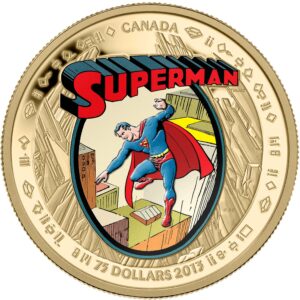
Superman in gold. One of the Canadian commemorative coins of 2013, with a denomination of $75). Photo: Royal Canadian Mint
Other countries take a more relaxed view. In 2013, for example, Canada issued some commemorative coins to mark the 75th anniversary of Superman – after all, one of the superhero’s co-creators was Canadian! Canada went on to honour more superheroes, as well as Looney Tunes characters such as Bugs Bunny and Daffy Duck, with their own coins.
Among the very first coins featuring comic characters are the commemorative coins from the Cook Islands, produced by the Perth Mint, that depict Mickey Mouse (1996) and lazy cat Garfield (1999). 1996 also saw the Flintstone family featured on commemorative coins from Gibraltar. This was the starting point for cartoon characters on coins. In the new millennium, it really took off!
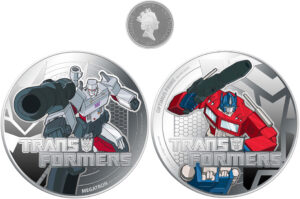
Robots in disguise! In 2013, Optimus Prime and Megatron, the hero and the antagonist of the ‘Transformers’ comics, were featured on the 2 dollar coin of Niue. Photo: New Zealand Mint.
A Flood of Comic Coin Motifs
Of course, this was a calculated move: coin motifs reach a larger target group, appealing to both younger audiences and nostalgic collectors who grew up with these characters. And, in many cases, these motifs capture people’s attention much more effectively than the deadly serious themes addressed by major national mints, which produce commemorative coins to mark the anniversaries of historical events or important thinkers. These coins may be very dignified, but they don’t have a very wide-reaching appeal. Mints have to move with the times!
There’s a lot of money to be made from collector coins featuring figures and themes from pop culture – a fact that the New Zealand Mint, which mints coins on behalf of the island of Niue in the South Pacific, quickly caught onto. And of course, that includes comics! From Snoopy and classic Disney characters, to superheroes, transformers and Miffy. From Soviet/Russian cartoon series ‘Nu, pogodi!’ to Japanese franchises such as Hello Kitty or Pokemon: between 2001 and 2015, Niue featured all of these characters on commemorative coins, which often had high mintages. And it doesn’t look as if that’s going to stop any time soon.
The Big Exception
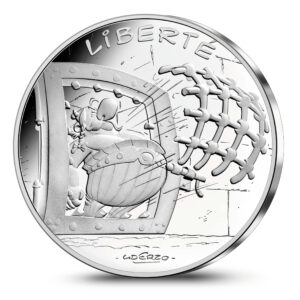
Liberté! The legendarily strong Obelix represents part of the national motto of France, depicted bursting open a prison cell door with his stomach. Photo: Monnaie de Paris.
In Europe, most countries barely feature comic book characters on the coins. Well, not entirely… One country of indomitable Gauls won’t stop minting coins with comic motifs! France is the big exception. Just like in Belgium, comics have a long-standing tradition in France, whose people therefore have a different level of appreciation for the genre. And not only that: comics have become part of these countries’ national identities, which is rather difficult for us to imagine. This applies to both Tintin and Lucky Luke, but above all to Asterix and Obelix, who have appeared on French commemorative coins since 2007. A series of coins issued in 2015 illustrates just how highly comics are regarded in France:
It is titled ‘The values of the Republic – Les valeurs de la République’ – freedom, equality, fraternity and peace. These values are symbolised by various scenes from Asterix. For instance, by the strong Obelix, who represents ‘Liberté!’ by bursting open a prison cell door with his stomach (of course we’re not implying anything offensive about Obelix’s weight!). Let’s take a moment to consider the significance of these coins!
The Monnaie de Paris not only honours French characters with their own coins: in recent years, it has regularly produced commemorative coins celebrating Mickey Mouse and other Disney characters. The ‘Mickey Through The Ages’ series, issued in 2016, presented the different stages of this world-famous mouse’s artistic evolution. It was the first time Mickey Mouse had ever been featured on a Euro collector coin. 2017 saw a series of coins dedicated to Scrooge McDuck and his ‘DuckTales’ family – After all, Scrooge is technically a coin collector, even if his primary goal is to have enough coins in his vault to literally swim in them! In 2018, the Monnaie de Paris also issued the lovely ‘Mickey & La France’ series, which depicted Mickey travelling in France as a tourist.
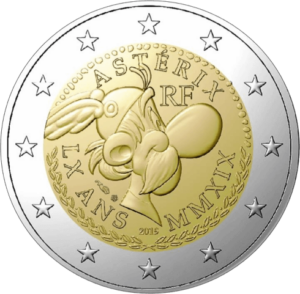
In 2019, Asterix became the first comic book character to be featured on a circulating commemorative coin. Photo: Monnaie de Paris.
The Peak of the Movement
In the end, it was the French who, last year, dared to take that final step and feature a comic book character on a circulating commemorative coin for the very first time: Asterix is back and, since March 2019, he has been circulating on 2 euro coins to mark the 60th anniversary of the character.
And that brings us back to the present. What will happen next? It doesn’t look as if comic book characters are going to disappear from our coins any time soon – quite the contrary…
Max and Moritz – a Beloved German Proto-comic
To finish off, let’s take a look at the situation in Germany. Comics aren’t as much of a national treasure for us it seems – not like sports, for example. But there’s one coin that could be considered a rare exception: in 2007 in Germany, a commemorative coin was issued to mark the 175th birthday of Wilhelm Busch, the creator of popular German illustrated story ‘Max and Moritz’. His illustrated stories are considered a kind of German proto-comic. The coin depicts both of the famous little rascals, alongside an image of their creator. That’s as close as we’ve come to featuring a comic book character on a coin.
That said, in the last few years, we German collectors have seen more collector coinage issued by the Berlin Mint, that feature our own childhood heroes, such as the ‘Sandmännchen’ (little sandman), the ‘kleine Maulwurf’ (little mole), the Smurfs and Maya the Bee.




